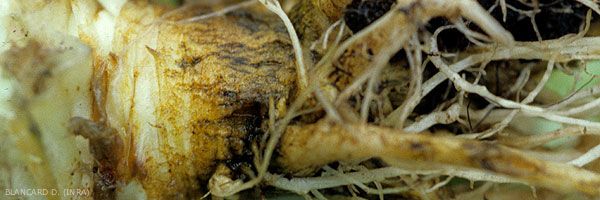
Large non-parasitic pivot
and Sphingomonas suberifaciens
(Corky roots)
The presence of more or less enlarged corky roots on lettuce has long been attributed to a non-parasitic disease. In fact, the situation is more complex and the cause of these symptoms may vary depending on the growing context.
Some authors have suggested the effects of phytotoxins released into the soil during the decomposition of green plant waste under very humid conditions. This situation is little reported.
Such symptoms are more frequently associated with too much nitrogen fertilization which results in the release of excess ammoniacal nitrogen and nitrites into the soil. There is also rotting of the lateral roots and a red to brown coloration of their stele. In this case, we are dealing with the disease non-parasitic "big pivot" , which manifests itself much less when one employs reasonable nitrogenous manures and nitrogen in the form of sulphate or nitrate. ammonium, urea or calcium nitrate (see Ammonia toxicity ).
More recently, an extremely difficult to isolate bacterium, Sphingomonas suberifaciens , has been associated with this type of symptoms in plots where crops of lettuce frequently follow one another. This bacterium is able to cause initially yellow lesions on the taproot and on the large lateral roots. These lesions take on a brownish hue and soon surround these roots, which sometimes swell. Subsequently, there is a significant superficial suberization of the tissues which split longitudinally (Figures 1 to 3). The pivot can be particularly affected, enlarging excessively from time to time (figure 4). In this case, we speak of a parasitic "Big pivot" , also called "Corky root" by the Anglo-Saxons. You can consult the link parasitic "Gros pivot" and the file Sphingomonas suberifaciens for additional information on this parasite.
It is quite obvious that in certain plots, one will be able to deal with the combined action of Sphingomonas suberifaciens and excessive nitrogenous manures. In addition, we will not systematically differentiate the large parasitic and non-parasitic pivots because their symptoms as well as the control methods to be implemented to control them are quite comparable.
The roots show yellowish lesions that turn brown quickly. We note in places, as on the pivot, a superficial suberization and longitudinal cracks. They also tend to swell. Their surface thus becomes rough and cracked; there are furrows, ridges, corky ridges on the root system.
The pivot is often very affected; it is strongly suberized and enlarged and becomes brittle.
NB: We advise you to consult the damage caused by Thielaviopsis basicola on salad roots. The latter are reminiscent of those caused by the diseases responsible for the parasitic "big pivots" or not.





